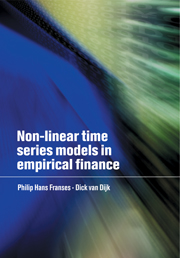5 - Artificial neural networks for returns
Published online by Cambridge University Press: 14 May 2010
Summary
Artificial neural network models (ANNs) are nowadays used in a large variety of modelling and forecasting problems. In recent years neural networks have found their way into financial analysis as well, as evidenced by conferences such as ‘Neural Networks in the Capital Markets’, and a large number of books (Trippi and Turban, 1993; Azoff, 1994; Refenes, 1995; Gately, 1996) and articles in scientific journals dealing with financial applications of neural networks. A casual literature search suggests that each year about 20–30 of such articles are published, dealing with modelling and forecasting stock prices (Gençay, 1996; Haefke and Helmenstein, 1996a, 1996b; Gençay and Stengos, 1998; Qi and Maddala, 1999), exchange rates (Kuan and Liu, 1995; Franses and van Griensven, 1998; Franses and van Homelen, 1998; Gençay, 1999), interest rates (Swanson and White, 1995) and option pricing (Hutchinson, Lo and Poggio, 1994; Qi and Maddala, 1995), among others. See also Qi (1996) for a survey.
The main reason for this increased popularity of ANNs is that these models have been shown to be able to approximate almost any nonlinear function arbitrarily close. Hence, when applied to a time series which is characterized by truly nonlinear dynamic relationships, the ANN will detect these and provide a superior fit compared to linear time series models, without the need to construct a specific parametric nonlinear time series model. An often-quoted drawback of ANNs is that the parameters in the model are difficult, if not impossible, to interpret.
- Type
- Chapter
- Information
- Non-Linear Time Series Models in Empirical Finance , pp. 206 - 250Publisher: Cambridge University PressPrint publication year: 2000



